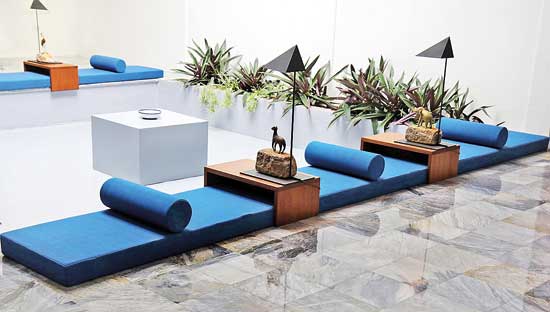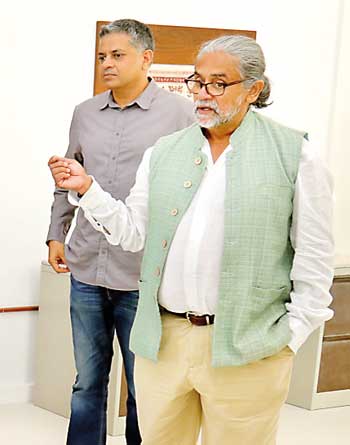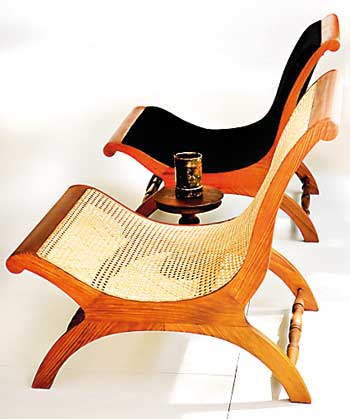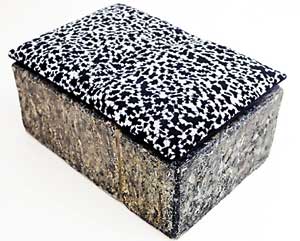Beyond buildings: Capturing Bawa’s vision for furniture
Geoffrey Bawa, widely regarded as one of the most influential architects of the 20th century, had a design philosophy that extended beyond buildings, seamlessly integrating furnishings into the fabric of the spaces he created. He believed that architecture and interiors were inseparable, maintaining an approach to furniture design that was deeply integrated with his architectural vision.
His creations were not standalone objects but part of a larger narrative that considered the interplay of light, space, materials and context. For Bawa, furniture was a natural extension of the spaces it inhabited, designed to complement and enhance its surroundings.

Sofa with mattress and cushions from Design in the Moment: Furniture by the Geoffrey Bawa Practice. Pix by M.A. Pushpa Kumara
This aspect of Bawa’s legacy is beautifully captured in ‘Design in the Moment: Furniture by the Geoffrey Bawa Practice,’ an exhibition by the Geoffrey Bawa Trust in collaboration with Bangalore-based furniture studio Phantom Hands. Founded by Deepak Srinath and Aparna Rao in 2014, Phantom Hands specialises in re-editing 20th-century classics and crafting contemporary collections rooted in South Asian culture.

Deepak Srinath and Channa Daswatte
“What began as a passion project has grown into a thriving ecosystem supporting over 120 skilled artisans,” shares Deepak, highlighting the studio’s dedication to traditional techniques like carpentry, cane weaving, and wood finishing. “More recently, we have begun expanding our repertoire by adding disciplines like metalworking to our skill set.”
The partnership for this collaboration began fortuitously, with Aparna connecting with the Geoffrey Bawa Trust, which was eager to showcase Bawa’s lesser-known work in furniture design. “I think there was a point at which the Bawa Trust was quite keen on showing the world that, yes, he was a great architect but that he also had other sides to him,” says Channa Daswatte, chairperson of the Geoffrey Bawa Trust. “We were keen on making reproductions of furniture and perhaps having a system in which it could help the trust by the sale of some of these objects. We didn’t push it along too much until Phantom Hands came along.”
Aparna recalls, “Initially, the idea was to license six iconic furniture pieces associated with Bawa’s architectural works and reproduce them. It seemed straightforward – until we delved deeper into the spirit of his creations.” The initial reproductions were technically well-executed, but something intan-gible was missing. “The prototypes felt soulless as if they lacked the essence of Bawa,” admits Aparna. Despite being faithful to the designs, the pieces seemed detached from the richness of their original context.
This unease sparked a pivotal decision: to step back, revisit Bawa’s work in Sri Lanka, and explore the depth of his design ethos. A visit to Sri Lanka, including a stay at the iconic Heritance Kandalama Hotel, designed by Bawa, proved eye-opening. There, Aparna encountered a diverse array of objects – benches, ashtray stands, lighting fixtures – that spoke volumes about Bawa’s intuitive approach to design.
“These pieces weren’t meticulously pre-planned; they felt like brushstrokes of a master painter – improvised, yet deeply intentional,” Aparna reflects. This revelation redefined the team’s understanding of Bawa’s design philosophy.
Back in Bangalore, Phantom Hands embarked on an ambitious phase of prototyping. By meticulously analysing measurements, materials, and forms, they uncovered recurring geometries and patterns that tied Bawa’s seemingly disparate designs together.

Bentota lounge chair
Recalling his visit to the Phantom Hands Studio, Channa says, “I walked into a room filled with prototypes, and for the first time, I saw these pieces as a cohesive collection. Aparna and her team had captured Bawa’s spirit in a way that left me speechless.”
The collaboration sparked deeper questions: What does it mean to be authentic to a legacy? How do you reinterpret designs created decades ago for a contemporary audience? Aparna, Deepak, and Channa navigated these challenges through countless conversations and experiments. They grappled with decisions about materials, dimensions, and production techniques, always asking, “What would Geoffrey have done today?”
The Geoffrey Bawa Collection is a culmination of these efforts; a collection that is as much a tribute to Bawa as it is a reinterpretation of his work. The project is deeply personal for Channa; “To see all these pieces together for the first time—pieces that were created for specific contexts and projects—it felt like Geoffrey might walk into the room at any moment. That’s the spirit we hope to share.”
One particularly evocative exhibit features a stone seat with a cushion inspired by Bawa’s Dalmatians, a small but profound reminder of how objects hold personal histories. Another fascinating piece is a hand-crafted paper lamp, a playful experiment in creating something beautiful from simple materials like sheet metal and paper.
Similarly, an ashtray originally designed in terracotta that ensures cigarettes won’t extinguish prematurely, combines creativity with practicality. Another standout is a table featuring recycled marble slabs repurposed from old floors. The exhibition also features furniture that blurs the line between art and usability. A versatile sofa designed in the 1960s reflects this philosophy with a mattress and cushions that can be rearranged to suit multiple seating preferences.
Bawa’s designs frequently drew from traditional forms, reinterpreting them for contemporary use. For instance, he reimagined the humble monk’s offering table, which was originally used for dining while seated cross-legged, into a stool for setting down one’s drink. Similarly, Bawa’s ‘Next-Door Café Chair’, his take on the safari chair—a classic design introduced during colonial times – paid homage to its origins while adding a distinctly Sri Lankan twist.

Stone seat with a cushion inspired by Bawa’s Dalmatians
Although some of his works have been lost to time, such as many of the dining chairs designed for the Bentota Beach Hotel and later the Triton Hotel (now Heritance Ahungalla), which were swept away by the 2004 tsunami, their spirit lives on in the enduring principles of his design philosophy.
Through this exhibition, the Geoffrey Bawa Trust and Phantom Hands celebrate the timeless elegance of Bawa’s furniture, while ensuring his legacy resonates with modern sensibilities. The Geoffrey Bawa Collection by Phantom Hands will be available for purchase in 2025.
Design in the Moment: Furniture by the Geoffrey Bawa Practice will be on view at the Geoffrey Bawa Space on 42/1 Horton Place, Colombo 7, until May 31, 2025.
Searching for an ideal partner? Find your soul mate on Hitad.lk, Sri Lanka's favourite marriage proposals page. With Hitad.lk matrimonial advertisements you have access to thousands of ads from potential suitors who are looking for someone just like you.


